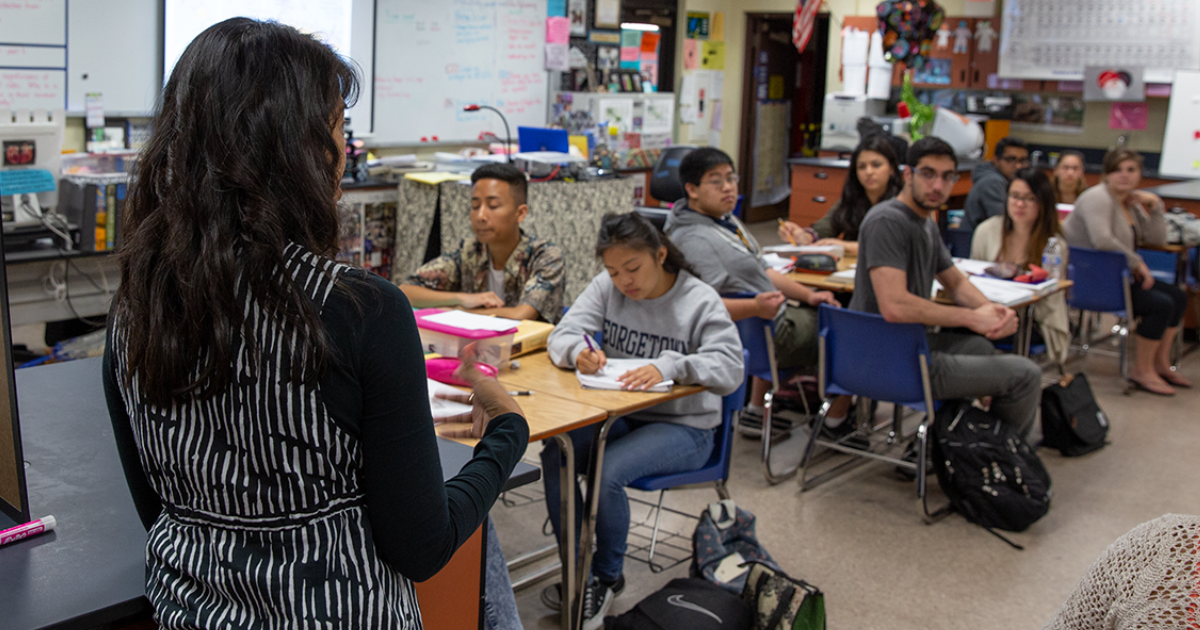Five Challenges to Integrating Math and Science Instruction
Posted on

By Meghan Macias, Research Associate in Science and Engineering at WestEd
Integrating mathematics and science has a significant impact on education and society as a whole. Bringing together these two subjects enables students to better understand the interrelatedness of the world around them. This integration encourages critical thinking and problem-solving skills essential for identifying solutions to today’s pressing local and global challenges, such as climate change, new energy demands, and dynamics related to an increasing global population. These challenges will not have simple solutions and will require both cross-disciplinary collaboration and knowledge of mathematics and science.
To better understand what integrated mathematics and science instruction looks like at the secondary level and how it can support diverse learners, my team—Ashley Iveland, Nicole Wong, and Kirsten Daehler—in WestEd’s Science and Engineering sought to highlight noteworthy examples that would provide context and inspiration for other secondary educators.
We recruited and conducted focus group interviews with math and science education experts, reviewed research literature, and interviewed in-service secondary math and science teachers. In this blog post, we highlight some of our findings regarding the following:
- what math and science integration is and what it looks like in secondary classrooms
- how integration supports student learning, especially for historically underrepresented minority (HURM) students, which we define as persons who are members of racial, ethnic, or gender groups that have been disproportionately underrepresented for more than 10 years
- what barriers or challenges exist to integrating the two disciplines
The full report, Identifying Connections Between Science Learning and Mathematics Education, provides more details and presents strategies for addressing the challenges outlined below.
What is Math and Science Integration?
Integrated instruction intentionally addresses mathematics and science standards (content and practices) for at least one grade, 6–12, within the same unit of instruction. Such instruction may occur in classes or programs that are labeled “science” or “mathematics” only, STEM, or other integrated programs (e.g., engineering academies or after-school programs).
Why is Math and Science Integration Important?
Research shows that girls and other HURM students are underrepresented in high-level STEM courses in middle and high school, STEM majors in college, and STEM careers; and girls often lose interest in STEM courses between grades 6–8. However, prior research shows that integrated instruction can support the retention of HURM students in STEM courses and helps students see the value of mathematics.
For example, previous research found that 10th grade girls’ mathematics grades were more strongly associated with their feelings about the usefulness of mathematics than they were for boys. Additionally, whether girls saw mathematics as useful was found to be a predictor of their persistence in mathematics.
These findings suggest a need to couch mathematics in authentic contexts that help students see the purpose and utility of mathematics, especially girls and other HURM students, which may help keep their interest in STEM courses and careers.
5 Challenges to Integrating Math and Science in the Classroom
Academic disciplines are structurally compartmentalized
The separation of math and science classes, teachers, curricula, professional learning opportunities, and resources reinforces the widespread belief that these disciplines should be taught and supported separately. However, as described in the full report, the disciplines have a long history of overlap and integration but have been siloed by the education system.
Prevalence of school structures and policies that promote gatekeeping courses
A set of structural barriers discussed in the literature are the historical norms around gatekeeping courses. Historically, students have been kept out of advanced science courses depending on their performance in mathematics. Prior research shows that taking higher level math classes in high school is related to whether students attend and finish college and, eventually, what jobs they are offered. Using mathematics performance as a deciding factor in what classes students take reifies patterns whereby students are segregated along racial lines.
Incongruence between math and science standards
Our focus group participants cited the misalignment between math and science standards as a major challenge encountered when trying to integrate mathematics and science in their teaching. One middle school science teacher noted that the Common Core State Standards in mathematics and the Next Generation Science Standards do not “chronologically line up well.” He went on to explain that “misalignment makes [integration] difficult when standards exist but are not in sync with each other.”
Lack of curricula for integrated instruction
A study by Brown and Bogiages (2019) found that there is a dire need for integrated mathematics and science activities that can be easily implemented by secondary teachers. They determined that there is currently a lack of curricular materials teachers would like to use and would feel prepared to use with students.
Undervaluing of historically minoritized perspectives in math and science
Educators need to shift from thinking about the disciplines as siloed from each other toward viewing the disciplines as integrated in authentic contexts. What counts as meaningful or legitimate ways of figuring out or knowing in mathematics and/or science must expand to include other ways of knowing and viewing phenomena, especially those ways that are affiliated with Indigenous or minoritized perspectives and traditions. Taking an expansive stance toward math and science education can advance both teachers’ and students’ understanding of equity.
Download Identifying Connections Between Science Learning and Mathematics Education to learn promising practices and strategies for promoting math and science integration, including profiles of teachers integrating mathematics and science instruction.
 Meghan Macias is a Research Associate in the Science and Engineering content area at WestEd. Macias worked on an NSF-funded study investigating middle-school teachers’ enactment of the Next Generation Science Standards (NGSS) across the state of California. In her other projects, she investigates how professional learning, curricula, and other general support structures assist K–8 teachers to teach science. In particular, she investigates how teachers can better teach minoritized students, such as multilingual learners.
Meghan Macias is a Research Associate in the Science and Engineering content area at WestEd. Macias worked on an NSF-funded study investigating middle-school teachers’ enactment of the Next Generation Science Standards (NGSS) across the state of California. In her other projects, she investigates how professional learning, curricula, and other general support structures assist K–8 teachers to teach science. In particular, she investigates how teachers can better teach minoritized students, such as multilingual learners.
